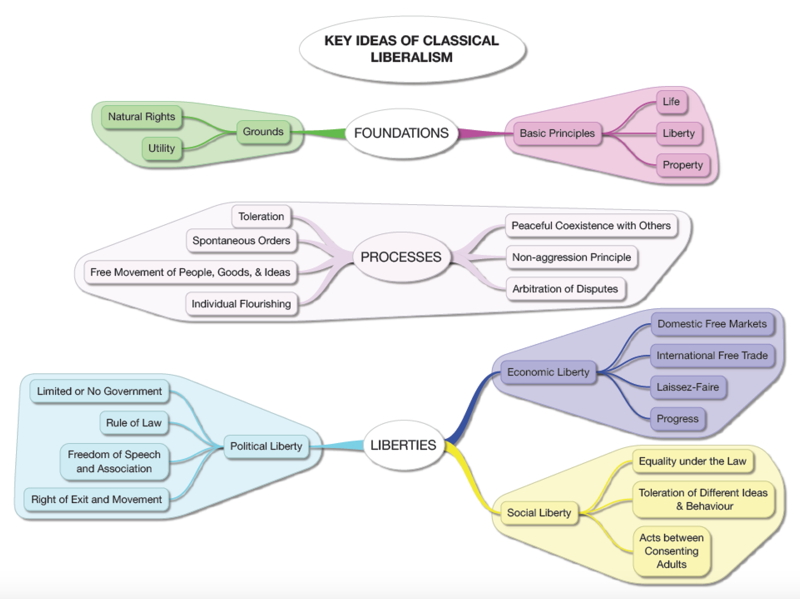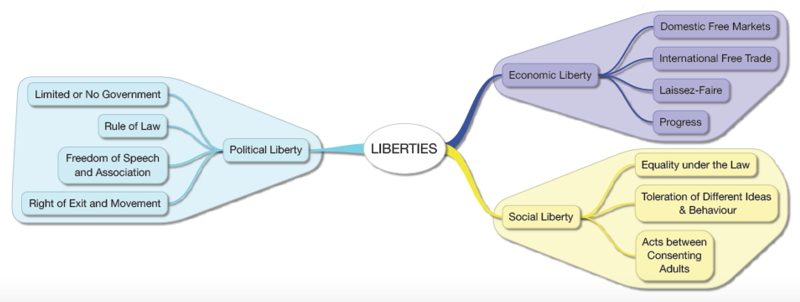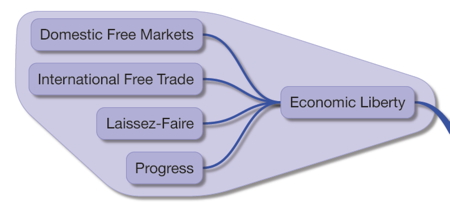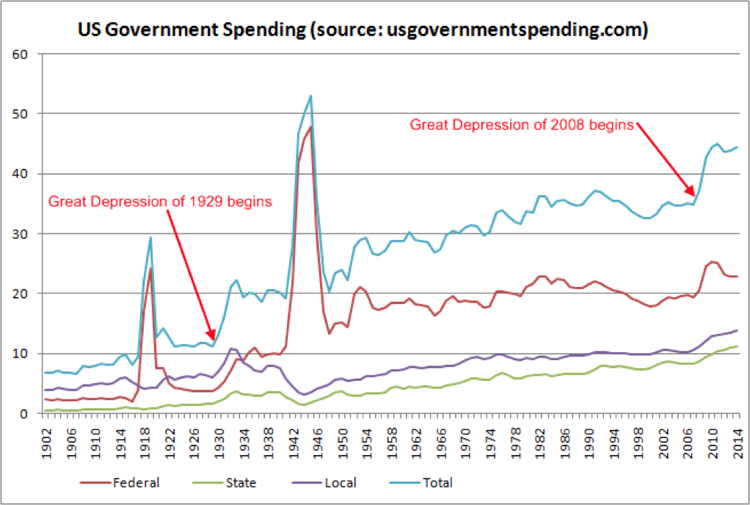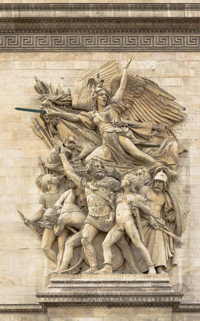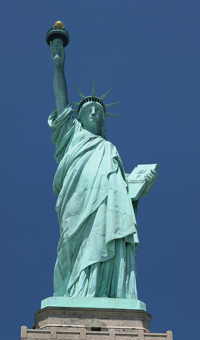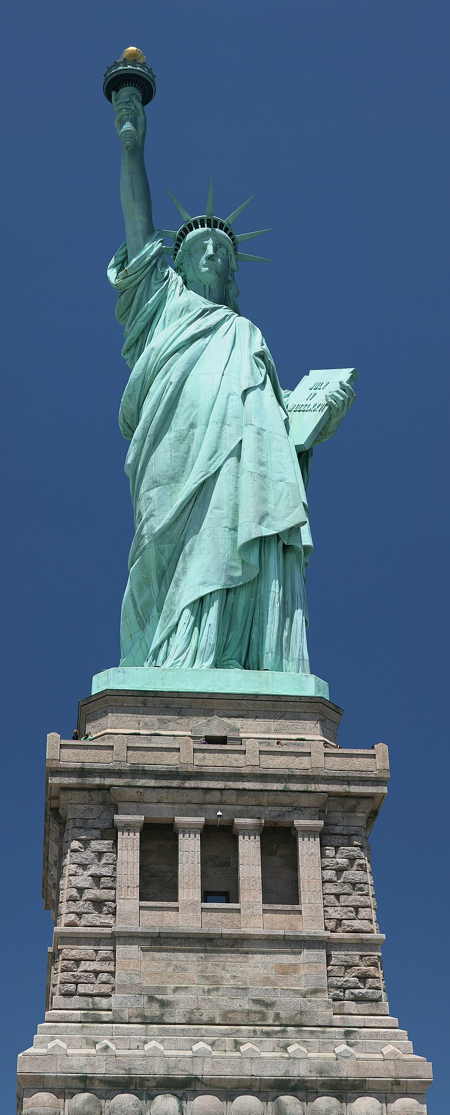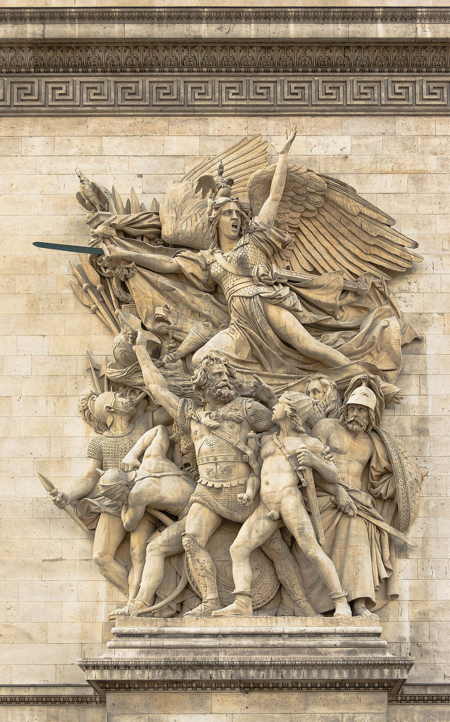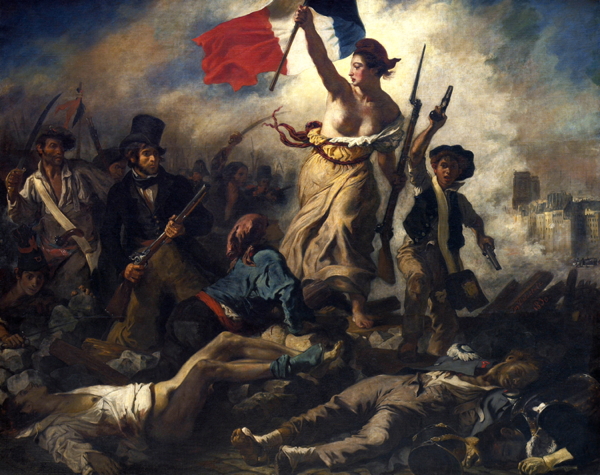[Note: This post is part of a series on the History of the Classical Liberal Tradition]
The Intellectual and Political History of the Liberal Tradition
There is a complex relationship between the emergence and development of political and economic ideas about liberty and the actions taken by people to put these ideas into practice. Elsewhere I have explored some of these relationships from an “Austrian” perspective, where I apply some of the ideas of the economist Ludwig von Mises concerning how individuals understand their own “interests”, the “ideas” people have about what their interests are, and how they take “action” in order to satisfy these interests.
Some of the “interests” which people have are political in nature or can only be understood through the “intellectual filter” of the political ideas they happen to have at any given time. For example, a personal might value “freedom” for its own sake, as they enjoy making decisions to do certain things without having others make those decisions for them, and exercising their freedom in order to pursue those interests. Or they might think that “freedom” is the best tool available for them (and others) to achieve whatever interests and goals they might have. And also, people reflect upon their past successes and failures in formulating and achieving their goals, learn lessons from these, and adjust their thinking accordingly. Thus, I would argue, there is a complex relationship between ideas, interests, and actions which I cannot explore in detail here.
I have used this approach in my study of the history of classical liberal ideas, the actions individuals have taken over the century to create liberal institutions of various kinds, and the changes people have made to their thinking in the light of their successes and failures, which I would like to outline here.
Liberal Movements and the Ideas which have inspired them
In summary, I argue that “pro-liberty intellectual and political movements were a reaction to and opposition against the abuse of political power.” [See the sections on “What Classical Liberals were For” and “What Classical Liberals were Against.”] Ideas about individual liberty did not appear in a vacuum but were often inspired by the political events which were going on around them and in turn inspired others to take political action to put these ideas into practice. The way in which theoretical ideas are spread to a broader, popular audience, is a complex matter which I cannot go into detail here, except to say that there have been numerous “transmission belts” which historians have studied. [The role of what I call “intellectual entrepreneurs” is very important and significant.]
Take one example to illustrate this process, John Locke’s Two Treatises of Government (1688). Locke had been influenced by the political writings of the radical Leveller movement of the 1640s. He wrote his treatise in the midst of another political crisis which led to the removal of the last of the Stuarts and the coming to power (by a virtual coup d’état) by a Dutch Prince, William of Orange. His ideas were taken up by two English writers (who were “journalists” in a way) in their weekly columns which were widely read and discussed in the North American colonies in the 1720s. Lockean ideas were also spread through sermons preached by liberal ministers in the colonies, and read by the leadership of the revolutionary movement which would defeat the British empire in a war and create the American Constitution 100 years after the appearance of Locke’s book. Thus, Lockean ideas about “the consent of the governed” (to take only one of his many influential ideas) went from words written on the page of his theoretical treatise, to the Declaration of Independence and the Constitution of the United States, and then into the popular culture of American democracy.
I think we can multiply this specific example many times when we study the “classical liberal” movement over the past 400 years.
Note: I have developed my own “70 Year Rule” to explain how long it takes for ideas to go from pure theory to practical application. For example, it was 70 years after the appearance of Adam Smith’s treatise on The Wealth of Nations (1776) that his free trade ideas were successfully put into practice in England with the repeal of the Corn Laws in 1846 by the “political entrepreneur” Richard Cobden. On the other side of the political ledger, it was nearly 70 years after the publication of Karl Marx’s Communist Manifesto (1848) and the coming to power of Lenin in the Bolshevik Revolution in 1917. The example of John Locke and the American Revolution stretches my 70 Year Rule to nearly 100 years but the idea is still the same.
The following is a list of the most significant moments during this period when CLs developed ideas about liberty and attempted to put them into practice in order to create a freer society. There are four key periods of more intense activity (or “clusters”) when CL ideas were especially prominent and influential, namely:
- 1640s: the English Civil War and Revolution (proto-liberalism)
- 1750s-1790s: the American and French Revolutions (early liberalism, the “liberal “ Enlightenment)
- the long liberal 19th century 1815-1914 (classical liberalism)
- the post-WW2 liberal renaissance and the rise of “libertarianism”
There was also a long period of what I term the “pre-history” of liberal thought during which some key ideas which would later become part of the we now know as “liberalism” were developed by people who could not be called “liberals” but who are nevertheless important for understanding its history.
What follows is an intellectual and historical “road map” which is designed to lay out the “big picture” of a tradition which has been more than 400 years in the making. Wherever possible I have provided links to the relevant articles of the online version of the Encyclopedia of Libertarianism (Sage, Cato Institute, 2008) which is an excellent, concise guide to this history. It originally appeared on the Learn Liberty website with a table of contents modelled closely on the print edition.
Note 1: I first made links to this version but later it was changed to a much less useful list of contents. I have retained the older links as they seem to be automatically redirected to the new version without problem. I have also created my own table of contents for the Encyclopedia which I think is more useful
Note 2: I wrote the entries on the French Revolution and many of the French liberals.
Note 3: For each of these key periods and movements we can list an important theoretical text which inspired many of the participants, a means by which these ideas were spread to a broader audience, and a key document which was produced, such as a Declaration of Rights or a Constitution. I plan to add examples of these later.
The Pre-History of Liberalism: Precursors and Influences
- Greek ideas about democracy; the independent self-governing polis; the existence of a higher moral law
- Roman ideas about natural law; property law; the problem of the tyrant king/emperor; tyrannicide: Stoicism and Epicurianism; Cicero – Stoicism; Epicureanism; Cicero (106-43 BC); Natural Law
- Christian ideas about the individual soul; the higher moral law; the early church as a voluntary, self-governing association; the abbey/monastery as an early form of the “firm”; decentralised decision-making and governance; overlapping jurisdictions / legal polycentism
- the Medieval Period: Magna Carta – Magna Carta; the Free Cities and their Charters; Scholastics – School of Salamanca – Scholastics/School of Salamanca
- the Renaissance Republicanism; the independent republican city and its citizens; self-governance and political independence from the central power (monarchy, or pope); rule by a pro-trade, commercial oligarchy; opposition to tyrants/tyranny: Classical Republicanism – Republicanism, Classical; The Dutch Republic – Dutch Republic
(1) 1640s: the English Civil War and Revolution (proto-liberalism)
- English Common Law: Edward Coke – Common Law;
- The English Civil Wars/Revolution of the 1640s: the Levellers, John Lilburne, Richard Overton, William Walwyn, John Milton – English Civil Wars; Levellers; Milton, John (1608-1674)
- the Glorious Revolution of 1688: Algernon Sidney, John Locke, Whigs – Glorious Revolution; Sidney, Algernon (1623-1683); Locke, John (1632-1704)
(2) 1750s-1790s: the American and French Revolutions (early liberalism, the “liberal “ Enlightenment)
The 18thC Enlightenment in Europe and North America – Enlightenment:
- 18thC Commonwealthmen, Cato’s Letters, Trenchard and Gordon – Cato’s Letters
- The Scottish Enlightenment: Adam Smith, Adam Ferguson, David Hume – Smith, Adam (1723-1790); Ferguson, Adam (1723-1816); Hume, David (1711-1776)
- The French Enlightenment: Physiocracy, Montesquieu, Voltaire, Diderot – Physiocracy; Montesquieu, Charles de Secondat de; Voltaire (1694-1778); Diderot, Denis (1713-1784)
- Economic Thought: Adam Smith, the Physiocrat, Turgot – Turgot, Anne-Robert-Jacques (1727-1781)
The 18th Century Revolutions:
- The American Revolution: Thomas Paine, Thomas Jefferson, James Madison – American Revolution; Paine, Thomas (1737-1809); Jefferson, Thomas (1743-1826); Madison, James (1750-1836)
- The French Revolution: Lafayette, Condorcet, the Girondins, Destutt de Tracy, Madame de Stael – French Revolution; Condorcet, Marquis de (1748-1794); Tracy, Destutt de (1754-1836);
(3) The long 19th century 1815-1914 (classical liberalism)
19th century Classical Liberalism:
- Classical Liberalism (the English School): Philosophic Radicals, Utilitarianism, Jeremy Bentham, James Mill, Classical Economics, John Stuart Mill – Liberalism, Classical; Philosophic Radicals; Utilitarianism; Bentham, Jeremy (1748-1832); Classical Economics; Mill, John Stuart (1806-1873)
- Classical Liberalism (the French School): Jean-Baptiste Say, Benjamin Constant, Charles Comte, Charles Dunoyer, Frédéric Bastiat, Gustave de Molinari – Say, Jean-Baptiste (1767-1832); Constant, Benjamin (1767-1830); Comte, Charles (1782-1887); Dunoyer, Charles (1786-1862); Bastiat, Frédéric (1801-1850); Molinari, Gustave de (1819-1912)
Key issues and movements:
- the Abolition of Slave Trade and Slavery: Clarkson, William Wilberforce, William Lloyd Garrison, Frederick Douglass, John Brown, Lysander Spooner – Abolitionism; Slavery in America; Wilberforce, William (1759-1833); Garrison, William Lloyd (1805-1879); Douglass, Frederick (1818-1895); Brown, John (1800-1859); Spooner, Lysander (1808-1881)
- Constitutional Monarchism: Benjamin Constant – Constitutionalism; Constant, Benjamin (1767-1830)
- Free Trade Movement: Anti-Corn Law League, Richard Cobden, John Bright; Bastiat, Michel Chevalier – Anti-Corn Law League; Free Trade; Cobden, Richard (1804-1865); Bright, John (1811-1859); Bastiat, Frédéric (1801-1850)
- 1848 Revolutions: constitutionalism and abolition of serfdom
- opposition to war and empire: Cobden, Bright, W.G. Sumner – War; Peace and Pacifism; Cobden, Richard (1804-1865); Bright, John (1811-1859); Sumner, William Graham (1840-1910)
- Feminism and Women’s Rights: Mary Wollstonecraft, J.S. Mill – Feminism and Women’s Rights; Wollstonecraft, Mary (1759-1797); Mill, John Stuart (1806-1873)
- The Radical Individualists: Thomas Hodgskin, Herbert Spencer, Auberon Herbert – Individualism, Political and Ethical; Individualist Anarchism; Spencer, Herbert (1820-1903); Herbert, Auberon (1838-1906)
- The Austrian School of Economics (1st generation): Carl Menger, Eugen von Böhm-Bawerk – Economics, Austrian School of; Menger, Carl (1840-1921); Böhm-Bawerk, Eugen von (1851-1914)
(4) The post-WW2 Liberal Renaissance and the Rise of “Libertarianism”
The Austrian School (inter-war years): Ludwig von Mises, Friedrich Hayek – Economics, Austrian School of; Mises, Ludwig von (1881-1972); Hayek, Friedrich A. (1889-1992)
The Post-World War 2 Liberal Renaissance:
- Institute of Public Affairs (IPA) (1943)
- Foundation for Economic Education (FEE) (1946): Leonard Read – Read, Leonard E. (1898-1983)– Mont Pelerin Society (1947): Milton Friedman, Karl Popper – Mont Pelerin Society; Friedman, Milton (1912-2006); Popper, Karl (1902-1994)
- Institute for Economic Affairs (IEA) (1955): Anthony Fisher, Arthur Seldon – Fisher, Antony (1915-1988);
- Liberty Fund (1960): Pierre Goodrich
- Institute for Humane Studies (IHS) (1961): F.A. Harper – Harper, Floyd Arthur “Baldy” (1905-1973)
The Austrian School of Economics (2nd generation):
- Mises, Hayek, Murray N. Rothbard, Israel Kirzner – Economics, Austrian School of; Mises, Ludwig von (1881-1972); Hayek, Friedrich A. (1889-1992); Rothbard, Murray (1926-1995); Kirzner, Israel M. (1930-)
Other Economic Schools:
- Chicago School of Economics: Milton Friedman – Economics, Chicago School of; Friedman, Milton (1912-2006)
- Public Choice Economics: James Buchanan & Gordon Tullock – Buchanan, James M. (1919-2013); Tullock, Gordon
The modern American Libertarian movement:
- Objectivism: Ayn Rand – Objectivism; Rand, Ayn (1905-1982)
- Murray Rothbard – Rothbard, Murray (1926-1995)
- Cato Institute (1974): Ed Crane, Charles Koch, Murray Rothbard
- the Libertarian Party (1971)
The Australia Workers Party (1975): John Singleton and Bob Howard

